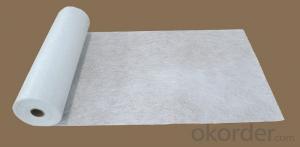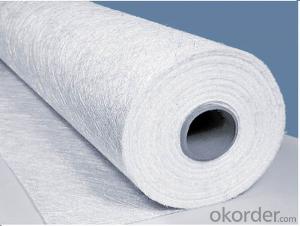Fiberglass Mat Tissue E-Glass Fiber Chopped Strand Mat Powder Bonded
- Loading Port:
- Shanghai
- Payment Terms:
- TT or LC
- Min Order Qty:
- 20000 kg
- Supply Capability:
- 200000 kg/month
OKorder Service Pledge
OKorder Financial Service
You Might Also Like
Brief Introduction
Chopped strand mat is made from chopped glass fibers, which are bonded with powder or emulsion binders. It can be used in hand lay-up process and continuous laminating process to produce FRP products, such as plates, lighting board, hull, bathtub, cooling towers, anti-corrosion materials, vehicles.
Characteristics
Good transparency for the laminates
Rapid wet out
Easy to remove air bubbles
Good dispersion and uniformity
High wet-strength retention
Good mechanical properties


Specification:
Property | Unit | Specification | Standard |
Density | g/m2 | 80-900 | ISO 3374-2000 |
Fiber Chopped length | mm | 50 | |
Sizing | Silane | ||
Filament Diameter | um | 11-13 | ISO 1888-1996 |
Bonder Content—Powder (%) | % | 3.5 +/-1.2 | ISO 1887-1995 |
Moisture Content (%) | % | < 0.20 | ISO 3344-1997 |
Width (mm) | mm | 100-- 3200mm |
Packaging:
The packing is according customer’s requirement. Each roll with a plastic bag and carton, then pallet with shrink film wrapped.
Storage:
Unless otherwise specified, Chopped Strand Mat should be stored in a dry, cool and rain-proof area. It is recommended that the room temperature and humidity should be always maintained at 15℃~35℃ and 35%~65% respectively.
- Q: Can fiberglass mat tissue be used for reinforcing fiberglass boats?
- Yes, fiberglass mat tissue can be used for reinforcing fiberglass boats. Fiberglass mat tissue is a non-woven material made up of randomly oriented fiberglass strands held together by a binder. It is lightweight, flexible, and easy to work with, making it an ideal choice for reinforcing fiberglass boats. When used in boat construction, fiberglass mat tissue is typically used in conjunction with fiberglass resin to create a strong and durable composite material. The mat tissue is laid down and impregnated with resin, which then cures and hardens to form a rigid structure. This process helps to increase the strength, stiffness, and impact resistance of the boat. Fiberglass mat tissue is commonly used in areas that require additional reinforcement, such as the hull, deck, or other high-stress areas. It helps to distribute and absorb forces, reducing the risk of cracking or failure. Additionally, it can provide added protection against impacts and abrasions, helping to prolong the lifespan of the boat. However, it is important to note that fiberglass mat tissue alone may not be sufficient for reinforcing fiberglass boats. It is often used in combination with other reinforcement materials, such as fiberglass cloth or woven roving, to provide a balanced and optimized reinforcement system. Ultimately, the use of fiberglass mat tissue for reinforcing fiberglass boats can greatly enhance their structural integrity and durability. It is a versatile and cost-effective option that is widely used in the boat building industry.
- Q: Can fiberglass mat tissue be used for bridge deck rehabilitation?
- Yes, fiberglass mat tissue can be used for bridge deck rehabilitation. Fiberglass mat tissue is a versatile material that is known for its high strength and durability. It is commonly used in construction projects, including bridge deck rehabilitation, due to its ability to reinforce and strengthen existing structures. Bridge deck rehabilitation involves repairing and restoring the deck of a bridge that has deteriorated over time. This process typically involves removing the existing damaged concrete, applying a new layer of concrete, and reinforcing it with materials such as fiberglass mat tissue. Fiberglass mat tissue is often used as a reinforcement material in bridge deck rehabilitation due to its excellent mechanical properties. It has high tensile strength, which helps to increase the load-bearing capacity of the bridge deck. Additionally, it is resistant to corrosion, which is particularly important in bridge decks that are exposed to harsh weather conditions and chemicals. Furthermore, fiberglass mat tissue is easy to install and can be applied to bridge decks of various shapes and sizes. It can be embedded into the new concrete layer during construction or applied as an overlay on the existing deck. This flexibility makes it an ideal choice for bridge deck rehabilitation projects. In summary, fiberglass mat tissue can indeed be used for bridge deck rehabilitation. Its high strength, durability, and resistance to corrosion make it a suitable reinforcement material for repairing and strengthening bridge decks. Its ease of installation and versatility further contribute to its suitability for this application.
- Q: How is fiberglass mat tissue used in the production of shower enclosures?
- The production of shower enclosures commonly utilizes fiberglass mat tissue due to its exceptional properties and advantages. This thin and flexible material consists of fine glass fibers that are randomly distributed and bonded together with a resin binder. To strengthen and enhance the shower enclosure, fiberglass mat tissue is primarily used as a reinforcement material. It is applied to the enclosure's surface to improve its strength, durability, and resistance to cracking or breaking. Initially, the fiberglass mat tissue is cut and sized according to the specific dimensions of the shower enclosure. It is then carefully placed or applied onto the enclosure's surface, typically through a process known as hand lay-up or spray-up. The mat tissue is strategically positioned to cover critical areas requiring reinforcement, such as corners, edges, and joints. Once the mat tissue is in position, a resin, usually polyester or epoxy, is applied over it. The resin penetrates the fiberglass mat tissue and bonds with the fibers, creating a solid and sturdy composite structure. This combination of resin and fiberglass provides additional strength and stability to the shower enclosure, making it more resistant to impact, stress, and water or humidity. Additionally, fiberglass mat tissue also contributes to the overall appearance of the shower enclosure. It helps achieve a smooth and uniform surface finish, eliminating imperfections and creating an aesthetically pleasing look. The mat tissue can be easily molded or shaped to match different designs and styles, enabling manufacturers to produce shower enclosures of various shapes, sizes, and patterns. In conclusion, fiberglass mat tissue plays a crucial role in the production of shower enclosures by offering reinforcement, strength, durability, and aesthetic benefits. This versatile material enhances the overall performance and visual appeal of the enclosures, ensuring they can withstand daily use and maintain their quality over time.
- Q: What is the expected lifespan of fiberglass mat tissue in residential applications?
- The lifespan of fiberglass mat tissue in residential applications can differ based on various factors like material quality, installation process, and environmental conditions. On average, these tissues are designed to last approximately 20 to 30 years. Residential applications commonly utilize fiberglass mat tissues for reinforcement and strengthening, particularly in moisture-prone areas such as bathrooms, kitchens, and basements. They are renowned for their exceptional resistance to mold, mildew, and rot, making them a favored choice in these locations. Proper installation and maintenance of fiberglass mat tissues can provide lasting support and protection to underlying surfaces. However, it is essential to handle and install them correctly to avoid damage. Improper installation or exposure to extreme conditions like excessive heat or direct sunlight can significantly shorten their lifespan. Regular inspection and maintenance are crucial to ensure optimal performance and longevity of fiberglass mat tissues. This entails checking for signs of wear, tear, or water damage and promptly addressing any issues that arise. Periodic cleaning and sealing can also help extend the material's lifespan. In conclusion, while the typical lifespan of fiberglass mat tissue in residential applications is around 20 to 30 years, it is vital to consider factors such as quality, installation, and maintenance to ensure durability and longevity.
- Q: What are the different types of fiberglass mat tissue available?
- There are various types of fiberglass mat tissue available, including chopped strand mat (CSM), continuous filament mat (CFM), and surface veil mat. Each type has different characteristics and is used for specific applications in industries such as construction, automotive, and marine. CSM is commonly used for general purpose applications, CFM provides higher strength and stiffness, and surface veil mat is used for surface finishing and improving the aesthetics of fiberglass products.
- Q: What is the flexibility of fiberglass mat tissue?
- The flexibility of fiberglass mat tissue refers to its ability to bend, conform, or mold to different shapes or surfaces without breaking or losing its structural integrity. The unique properties of fiberglass, such as its high strength-to-weight ratio and dimensional stability, allow the mat tissue to be flexible while still maintaining its strength and durability. This flexibility makes fiberglass mat tissue a versatile material that can be used in a wide range of applications, including automotive parts, construction materials, and boat manufacturing. Additionally, the flexibility of fiberglass mat tissue enables it to be easily cut, shaped, or layered to meet specific design requirements or fit into complex or curved surfaces.
- Q: Can fiberglass mat tissue be used for automotive parts?
- Yes, fiberglass mat tissue can be used for automotive parts. It is commonly used in the automotive industry for various applications such as reinforcing panels, creating structural components, and improving overall strength and durability of automotive parts.
- Q: Can fiberglass mat tissue be used for reinforcement in composites?
- Yes, fiberglass mat tissue can be used for reinforcement in composites. It is commonly used as a reinforcement material in various composite applications due to its high strength, durability, and excellent bonding properties. The fiberglass mat tissue helps enhance the mechanical properties and structural integrity of the composite material.
- Q: What is the abrasion resistance of fiberglass mat tissue?
- The abrasion resistance of fiberglass mat tissue is high, making it suitable for applications that require durability and resistance to wear and tear.
- Q: Does fiberglass mat tissue provide any electrical insulation?
- Yes, fiberglass mat tissue does provide electrical insulation. It is commonly used as a reinforcement material in electrical applications due to its high dielectric strength and insulating properties.
Send your message to us
Fiberglass Mat Tissue E-Glass Fiber Chopped Strand Mat Powder Bonded
- Loading Port:
- Shanghai
- Payment Terms:
- TT or LC
- Min Order Qty:
- 20000 kg
- Supply Capability:
- 200000 kg/month
OKorder Service Pledge
OKorder Financial Service
Similar products
Hot products
Hot Searches
Related keywords



























